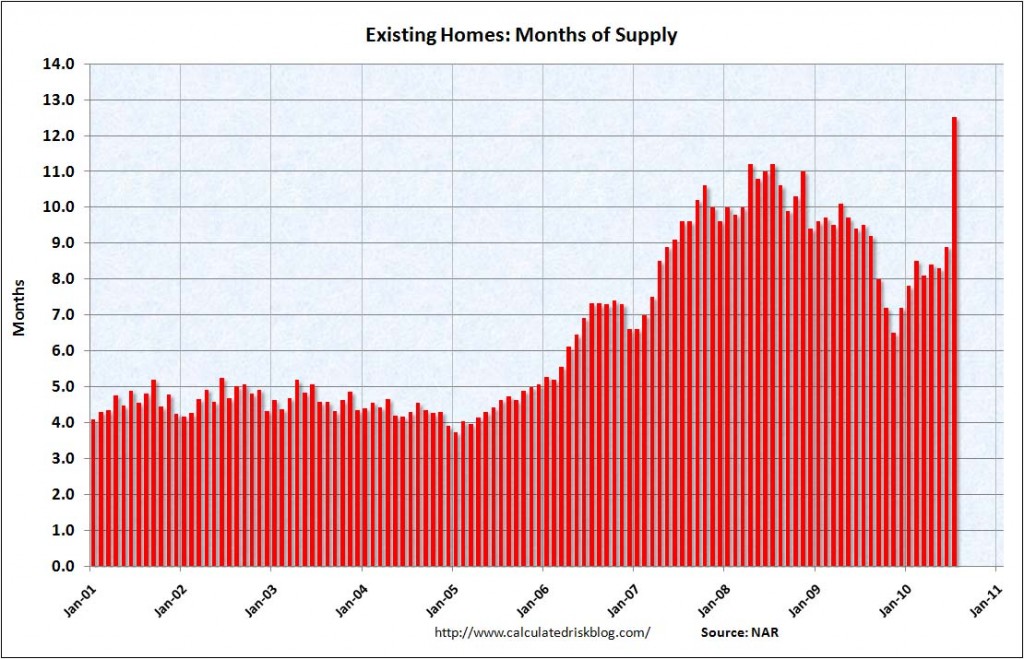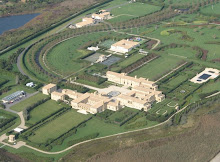
 On Tuesday the National Association of Realtors announced that existing home sales in the United States dropped a whopping 27.2% in the month of July. The consensus among analysts was that we would see a drop of around 13 percent, so when the 27 percent figure was announced it sent a shock through world financial markets. Only 3.83 million units were sold in July, which was down from 5.26 million in June, and which was the lowest number that the National Association of Realtors has ever seen since they began tracking this statistic back in 1999. To say that the real estate industry is alarmed by these numbers would be a tremendous understatement. What we are seeing unfold is essentially "Armageddon" for those involved in the housing and real estate industries. The real estate market is grinding to a standstill and a shockingly low number of people are actually in the market to buy a home right now. In the months ahead home sales may pick up a little bit, but only if housing prices start to fall. Why? Because right now there are tons of houses on the market and there are very few qualified buyers available to purchase them and potential buyers are starting to realize this. Buyers are beginning to understand that they have all the leverage now and they are waiting for prices to fall.
On Tuesday the National Association of Realtors announced that existing home sales in the United States dropped a whopping 27.2% in the month of July. The consensus among analysts was that we would see a drop of around 13 percent, so when the 27 percent figure was announced it sent a shock through world financial markets. Only 3.83 million units were sold in July, which was down from 5.26 million in June, and which was the lowest number that the National Association of Realtors has ever seen since they began tracking this statistic back in 1999. To say that the real estate industry is alarmed by these numbers would be a tremendous understatement. What we are seeing unfold is essentially "Armageddon" for those involved in the housing and real estate industries. The real estate market is grinding to a standstill and a shockingly low number of people are actually in the market to buy a home right now. In the months ahead home sales may pick up a little bit, but only if housing prices start to fall. Why? Because right now there are tons of houses on the market and there are very few qualified buyers available to purchase them and potential buyers are starting to realize this. Buyers are beginning to understand that they have all the leverage now and they are waiting for prices to fall.
Anyone who has taken Economics 101 in college knows that when supply is high and demand is low prices will fall, and that is exactly the situation we have in the U.S. housing market right now.
At the moment, most home sellers in the United States are very hesitant to lower the prices on their homes too much. Many have no intention of selling their homes below what they originally paid for them, and many others truly believe that the housing market will eventually rebound.
But the truth is that housing prices are simply not going to rebound to 2006 levels. If anything, they are going to continue to fall.
The following are the three basic points that every American needs to understand about the U.S. housing market right now....
1) There Is A Gigantic Mountain Of Unsold Homes On The Market
There are a staggering number of unsold homes on the market right now. As you can see from the chart from the Calculated Risk blog below, there is now over a year's worth of unsold homes flooding the marketplace....
So who is going to buy all of those unsold homes with so few qualified purchasers in the marketplace?
That is a very good question.
Unfortunately, all the signs indicate that the glut of unsold homes is going to get even worse.
As of this March, U.S. banks had an inventory of 1.1 million foreclosed homes, which was a new all-time record and which was up 20 percent from one year ago.
And the tsunami of foreclosures and repossessions just keeps growing....
*One out of every seven mortgages were either delinquent or in foreclosure during the first quarter of 2010.
*According to RealtyTrac, a total of 1.65 million U.S. properties received foreclosure filings during the first half of 2010.
*U.S. Banks repossessed 269,962 U.S. homes during the second quarter of 2010, which was a new all-time record.
The supply of unsold homes is already incredibly massive and it is growing at a staggering rate.
With such a flood of homes on the market, why in the world would anyone in their right mind pay a premium price for a home in 2010?
2) There Are Not Nearly Enough Qualified Buyers Seeking To Buy Homes
The banks and lending institutions that survived the subprime mortgage crisis of 2007 and 2008 learned some very valuable lessons. The days when even the family dog could get approved for a home loan are long gone. Now the pendulum has swung to the other end of the spectrum. Fearful of making more bad loans, banks and lending institutions have really, really tightened up lending standards. So a lot fewer people are getting approved for home loans these days.
That makes a lot of business sense for banks and lending institutions, but it also means that there are a lot fewer qualified buyers out there looking for homes.
Not only that, but millions of Americans who could potentially buy homes are waiting for the market to go down even further.
When you add that all together, you get the kind of home sales numbers discussed at the beginning of the article.
The Mortgage Bankers Association recently announced that demand for loans to purchase U.S. homes has sunk to a 13-year low. Unless the number of Americans getting approved for home loans starts increasing, you simply are not going to see housing numbers recover much.
And the truth is that Americans are not even doing much browsing for homes right now. Even Internet searches for homes are way down. Internet searches on real estate websites are down about 20 percent compared to this same time period in 2009.
So with a massive flood of houses on the market and with very few qualified buyers to purchase them, how in the world are housing prices supposed to go up?
3) The Housing Industry Will Never Fully Recover Without A Jobs Recovery First
In order to get qualified for home loans, Americans have to have good jobs first. But in this economy that is a huge problem.
Robert Dye, a senior economist with PNC Financial Services Group, recently told USA Today what he believes the bottom line problem of this housing crisis is....
"Jobs, jobs, jobs"
Today, 14 million Americans are unemployed and millions more are underemployed. Unfortunately, there are not nearly enough good jobs for all of them.
Today it takes the average unemployed American over 8 months to find a job. The number of Americans receiving long-term unemployment benefits has risen a staggering 60 percent in the past year alone.
Things have gotten so bad that according to one recent survey 28% of all U.S. households have at least one person that is searching for a full-time job.
To get an understanding of how horrific the unemployment situation has become in the United States, take 38 seconds to watch the incredible video posted below....
http://www.youtube.com/watch?v=9ssIhiD8kKM&feature=player_embedded
The truth is that without jobs, Americans simply cannot buy homes.
So is there any hope that we will see a robust jobs recovery any time soon?
Well, as I have written about previously, unfortunately there is every indication that the employment market is going to get even worse.
So the bottom line is that the housing market is going to continue to suffer.
There is going to continue to be a massive glut of unsold homes on the market.
There are going to continue to be very few qualified buyers in the marketplace.
Large numbers of Americans are going to continue to be unemployed.
Yes, that is a lot of bad news, but you aren't reading this column to get the same kind of mindless optimism that you get from the mainstream media news.




















































